spinach
The frequent randform reader knows that a lot of randform posts are concerned with questions about how to keep earth as a habitat for humans. One of the biggest problems seems to be: population growth. That is humans are the root cause of “pollution”, they are to a great extend causing climate change, they massively reduced the habitat for other beings including those in their own food chain and if their own strive for efficiency keeps on like that, then they (partially?) need to abolish themselves and eventually (?) start the AI machine population explosion-if they haven’t wiped themselves out beforehand in their wars for ressources.
But what really are the reasons for this human population growth?
This seems to be a very deep systemic question, but for me it is rather suggestive that this strive or “competition for efficiency” is playing a major role here. So today I would like to discuss this quest for efficiency again a bit at the example of agriculture.
One reason for population growth seems to be that something which could be called “sustaining a human” (whatever this encompasses) takes a lot of work. And it takes especially a lot of work to sustain not so efficient humans, like children or elderly people, but also humans who work in areas, where the benefit for mankind is not so clear etc.. By looking at this population growth it thus seems humans currently need more people and machines alone for the reasons to constantly increase their workforce. Note that this question of increase of the rate of needed workforce is of course linked to the question of economic growth.
But is it really true that alone for “sustaining themselves” humans need to increase their human or nonhuman workforce?
In the update of 21.10.2017 in the post Lobetal – In food chains I described, how my critisism about neglecting the (human) workforce in the calculations about whether 2000 m^2 of arable land is enough for sustaining one human, was not so well perceived.
That is in particular in the post “Volt ohne Raum” a quick back of the enveloppe calculation showed that: doing all agricultural tasks by hand is likely very space and energy-inefficient. And hence – especially given that there are other energy sources which are currently way more faster and with less space need than solar- we have meanwhile a giant agriculture industry, which produces human food rather efficiently. A fact, which can be -last but not least- seen when comparing prices for self-produced and for industrialized food. So in short: Space and Energy-inefficiency seems to be not the last word when it comes to inefficiency, but it does play a big role.
In fact growing crops by hand is so inefficient and expensive that I have problems to justify it to myself.
That is I’ve been growing plants for all my adult life and my production has sofar more or less steadily increased from some flowers to a meanwhile about 50 m^2 fruit/veggie plantation plus some trees, which conflicts more and more with the rest of my duties and projects and my age.
My plantation is of course quite expensive alone due to the fact that I currently have my “paddock” on potential appartment land in boomtown Berlin and since I didn’t inherit anything the soil comes with quite a mortgage. But it is also increasingly expensive not only in terms of labour for the mortgage but also in terms of pure labour for the outcome. That is I sofar use very few machinery (a lawn mower, a shredder, a chain saw and transport by car) and yes with increasing age you increasingly notice that you have just shuffled a ton of compost. Tim or the kids have done something once in a while, but it is basically me alone.
So what is it that I currently think produces most of the work ? Did I find some solutions to the corresponding problem?
Keeping a garden in shape is in general more work intense the more diverse and the more you want to harvest something. That is a lawn with some easy bushes can rather easily be kept in shape – especially with a lawn robot. Likewise if you have a wall around your garden and big trees are no problem – you may just let grow. But if you want/need to harvest – then things get more difficult. And by harvesting I would like to include “harvesting beauty” that is people put a great effort into shaping their garden in order to make it look “great”.
For the case of harvesting it is rather well-known that keeping low diversity may give you high gains on a short term because sowing and harvesting is easier. Maintaining low diversity gets though harder by repetative application, because monoculture is easier invaded, moreover soil ressources are faster expleted if crops are non-complimentary. High diversity though means – it may be hard to maintain and also hard to harvest.
So finding the right proportions and structure is crucial. People use the word “mixture” here, but I don’t really like the word “mixture” in this (and similar) context, because the word doesn’t reflect how difficult it is to put the parts together. In fact its not only me who seems to disapprove the term but gardeners here use the e.g. the word “mixed cultivation” or companion planting for a certain type of veggie/fruit planting which is an approach to higher diversity under the constraint of higher yields.
I’ve been using one certain mixed cultivation approach since a couple of years on one bedding. It has been described by Hans Wagner in his book Mischkultur. I currently don’t have the book at hand, but if I remember correctly he learned this approach himself from some female acquaintance.
At this place I would like to mention, that most of my gardening knowledge is by trial and error and some books – the open internet has been helpful on a couple of occasions but it is increasingly difficult to find profound information. In particular as said gardening is costly and yes there are some gardeners out there who are more “influencer” than real experts.
Anyways back to the question: what were my biggest problems sofar to keep the garden in shape, while still having something to harvest?
Since the garden contains a rather high diversity sofar pests and the like have been not such a big problem (maybe apart from slugs) as the need to keep some bushes and trees in shape (see randforms syringa post) and especially the need to keep the weeds in check. In the sequel I will report about partial “solutions” to the weed problem.
Weeding is nervy and rather work intensive, especially if you don’t want to use chemicals. Moreover things like flame weeding can backfire badly, so I used it sofar only on weeds between pavements. I was happy though that the specific “mixed cultivation” method from Wagners book worked out considerably well against weeds until about end of May. So it is at least somewhat a partial solution to the weed problem and I will thus report about it in the following passages and then in the images.
So what is that wondermethod?
Basically Wagner describes among others in his book that it is useful to sow spinach rows between the compagnion crops. The spinach is supposed to serve as a fertilizer plus it keeps the weed away plus it keeps the moisture in the soil plus it protects the fragile young crops during spring. The spinach rows should alternate with the crop rows every other year, so that the soil gets fertilized evenly.
What were my experiences with that method?
As said there were problems with slugs, which might have been attracted to the spinach, but the correlation is sofar unsettled. As a fertilizer the spinach is not enough, at least not on poor Brandenburgian sandy soil. But apart from that the spinach method worked sofar rather well for keeping the weeds away during spring time and for protecting the plants from wind and cold. It also keeps the moisture very well – as a plant and also as mulch, at least right after mulching. Here how this method looks like:
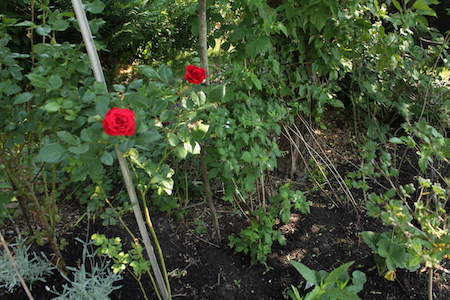
Rasberries, rubus and blueberries are here mulched with wood chips and compost, I will later add bark.
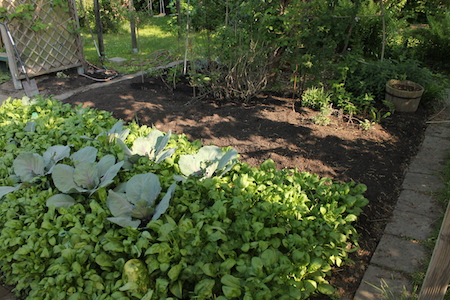
In the front the bedding with the spinach rows, behind it the rasberries, rubus and blueberries with a bedding inbetween, which is now filled with potatoes and beans.
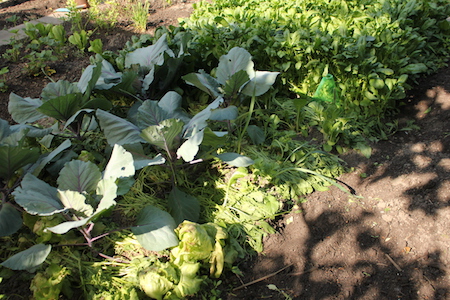
The spinach between the red cabbage has here been torn out and put as mulch in between.
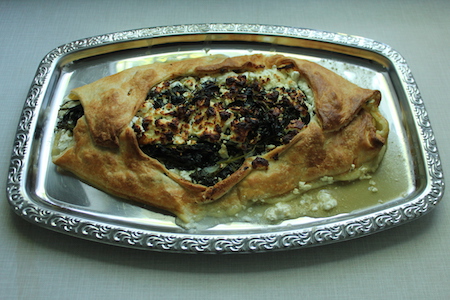
The spinach may not be sufficient as a fertilizer partly because partially it had been eaten.
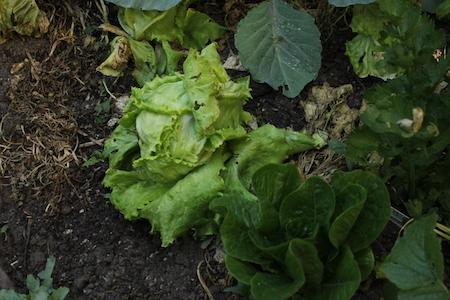
After a couple of days the spinach has shrinked and shriveled and has turned brown (here around the iceberg lettuce). As you can see there is not enough to cover all soil.
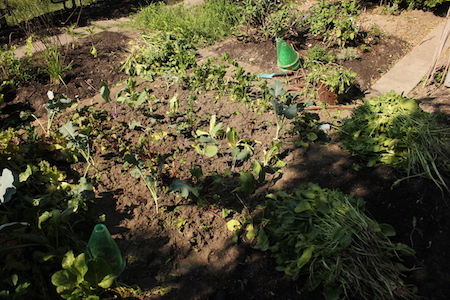
The other rows with stem turnip, broccoli, two types of celery and beetroot and salads after the spinach has been torn out and the weed in between removed.
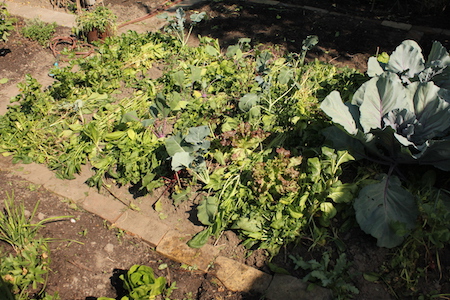
The same bedding as seen from the other side, with the piles of spinach put back as mulch. In some years I kept some spinach growing for harvesting seeds, but this reduces crop room and makes weeding a bit more laborious. So this year I was lazy and took down all the spinach. Spinach seeds are not cheap but affordable.
As said above the method works until end of May, after that the spinach mulch is not enough and I haven’t yet found a sufficiently satisfying approach for the rest of the year. Neither for mulching nor for weeding, which is partly due to the fact that the cut of the attached lawn is too infested with goutweed and couch grass.
End of story.
Some outlook on that:
The lawn is also “infested” with peat moss. Probably not the same type but some types of peat moss are currently quite under research as a subtitute for turf from peatlands. Turf from peatlands is as you may know under strong pressure because it can be used as an energy ressource (via burning) but also for soil enhancement. For harvesting turf, the peat has to be drained, but drained peatland is dangerous – especially for the climate – finally peatlands are a carbon sink etc. and in particular drained peatlands may easily burn. Some sources thus recommend some canadian sphagnum (like that) because “the industry is strictly regulated.”
So maybe in an upcoming post I may report about experiments with the lawn peat moss.
OK enough of agriculture – in the following some recent garden flower shots for those who kept reading until here:
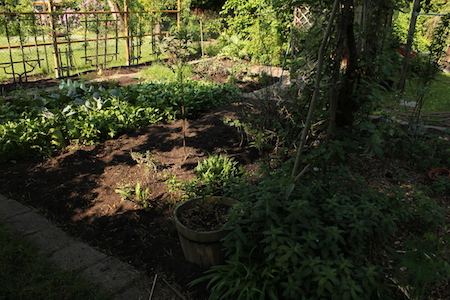
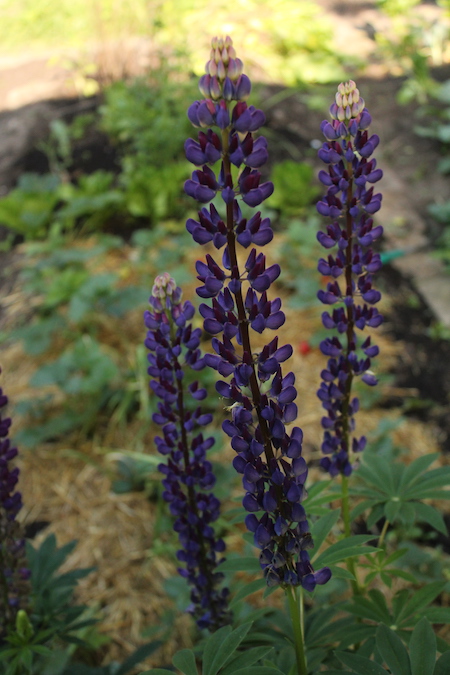
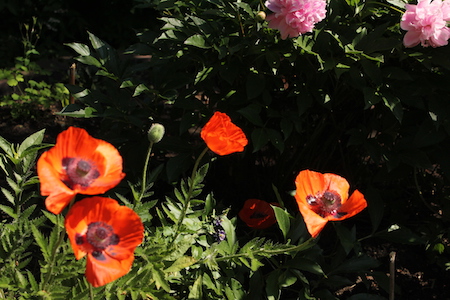
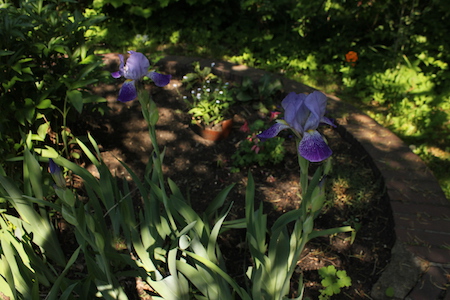
April 27th, 2019 at 8:35 am
How is your garden? Do you have a problem with Ambrosia artemisiifolia (ragweed) ? It seems to be pretty invasive, durable and of utmost allergologic relevance: https://www.ncbi.nlm.nih.gov/pmc/articles/PMC4861741/
Like did you have to notify authorities? https://www.umweltbundesamt.de/en/press/pressinformation/allergy-alert-action-day-to-fight-ragweed says:
The article is from 2015, so I imagine meanwhile they had set up a ragweed registry in your district?
May 5th, 2019 at 6:17 pm
@Compost Flute
This is my veggie garden as of today:
For the first time ever some bigger veggies like chard, celery, red cabbage and Brussels sprout kept growing over the winter. In the picture you can see a giant brusselsprout and a big red cabbage blossoming in yellow. The spinach is as tall as it was about 3 weeks later last year and in fact we already had spinach meals. It was also for the first time that I was harvesting salat already in April.
As far as I know there is no Ambrosia registry in Berlin. The german page of the Umweltbundesamt says that there are “Ambrosia-Scouts” which run around Berlin to tear out the plant. I haven’t seen any of these scouts yet, but I am aware of the Ambrosia problem. In fact there is one plant, which I have scrutinized rather closely, because it looks quite suspicious. It doesn’t seem to be Ambrosia artemisiifolia – given the scattered images which I found in the internet (unfortunately the video on the Umweltbundesamt webpage doesn’t show the plant in various growing stages but just some graphics)) . The suspicious thing may be some other Ambrosia, although the leaves look slightly differently than a lot of Ambosia types. I am actually close to tear it out completely because it looks as if it is blossoming soon and I haven’t yet figured out what it is. Maybe you know. It looks a bit like Valerian, but I am not sure, since it had been long ago that Valerian had been in the garden. Here it is:
May 9th, 2019 at 7:32 am
In a city full of people one would expect that there is more control over dangerous ragweed plants.
Allergic reactions can be fatal. Here what a doctor says:
where
And if you get more allergic due to your garden then why do you expose yourself to that green stuff? Move to the center of the city and you’ll be just fine.
May 26th, 2019 at 10:13 am
Haha – seems you ahve a lot of kale in your patch. Isn’t that a bit boring?
May 7th, 2020 at 6:54 pm
Aren’t you afraid that you accidentally might eat something poisonous?
June 1st, 2020 at 10:03 am
Nad, you wrote: “So maybe in an upcoming post I may report about experiments with the lawn peat moss.”
What happened to your moss experiments?
June 3rd, 2020 at 7:49 am
Sorry that I can’t answer all questions and comments. Here some new developments:
We took some moss out of the lawn, because it is not very sturdy, i.e. if you walk on it that might lead rather fastly to soil erosion.
I tried to use the moss as a mulch, but the racoons (or other animals ?) were immediately clumping in it and dispersing it. It also stored the moisture less good as I had hoped for.
Due to the heavy drought we have here since some years there are currently actually bad moss fires in Brandenburg:
https://www.rbb24.de/panorama/beitrag/av7/video-100-hektar-brand-loben-moor-elbe-elster-brandenburg.html
So -in short- I gave up on the moss idea.
This year I cut off some of the spinach and yet didn’t tear it out in order to protect the crops a bit against the sun:
More or less recently I have made some experiments with cardboards:
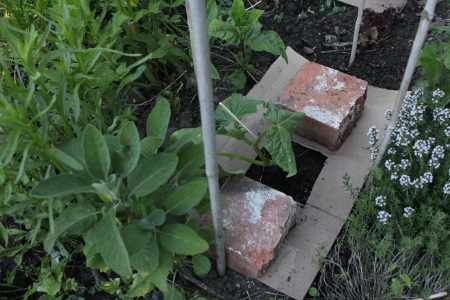
This is how it looks after some time, i.e. it gets lighter as if something is washed out. I am thus concerned of all the chemicals that might get washed out:
Where I have to say that of course I try to tear off plastic etiquettes, which though doesn’t always work:
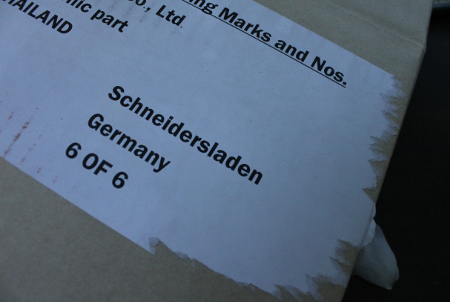
And of course I do not use coated and in particular glossy boards. I tried to find out, whether the paper which our organic grocery delivery uses can be used for composting, but they couldn’t tell me whether it can be or whether it can be not – it is only certified for “surface use”. As it is recycling paper it might quite not be suitable….
I recently found this certificate:
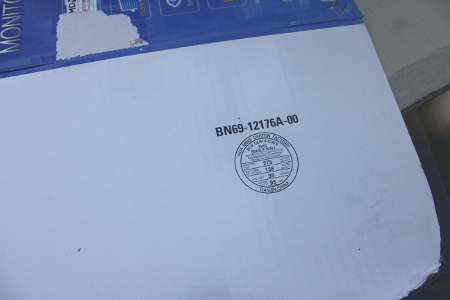
I don’t know whether you can read it, it gives the following indicators: bursting test (275 LBS per sqinch), min comb wt facings (138 LBS per MSQ FT), size limit (95 inches), GROSS WTLT (95 LBS).
So I would really like to see a certificate which gives an indication of how intoxicated a cardboard/paper really is.
June 7th, 2020 at 10:01 am
nad wrote: “At this place I would like to mention, that most of my gardening knowledge is by trial and error and some books – the open internet has been helpful on a couple of occasions but it is increasingly difficult to find profound information.”
There are so many good books and videos out there. It’s so exiting that people are sharing their discoveries and experiences! I find it more than disappointing that you are so easily dissmissing all that wonderful help.
June 16th, 2020 at 9:15 am
@Terassenfanatiker
I agree. In particular if nad would pay more attention to scientific papers then she would immediately understand that putting cardboards on soil is one of the worst ideas not only in terms of deposition of chemicals like by polyacrylates due to paper bonding but also with respect to the production of GHG emissions – here especially the methane!
That is in the article ‘Paper Vapour’ – the climate impact of paper consumption” by the European Environmental Paper Network (EEPN)
it is asserted that:
The World however needs to address sustainability challenges
Emphasis on “proper”!
Overall it should be said the:
Her approach of going towards intensive production systems with high GHG emissions is completely unsustainable.